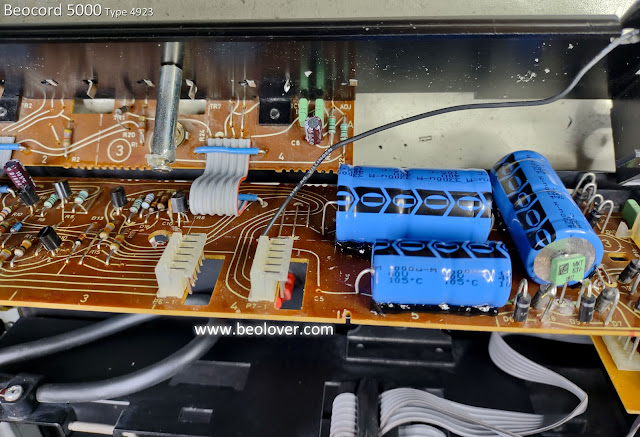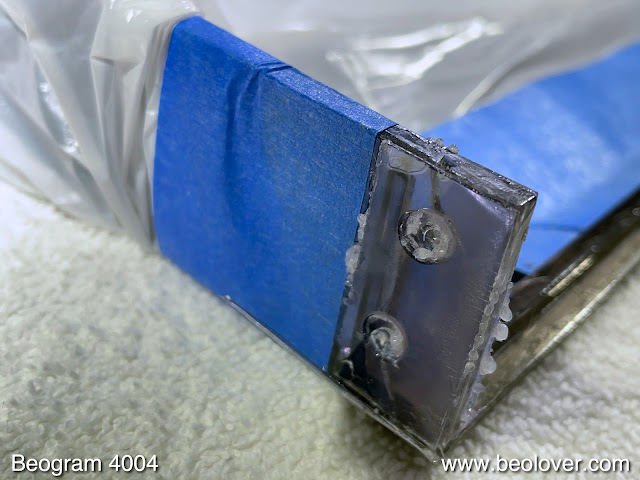After I repaired the hood of the Beogram 4004 (5526) from Florida, its owner decided to let me do a partial restoration. The unit had shown some platter RPM inconsistencies in the past, indicating that the DC platter motor bearings started to run dry of their oil reserves. This shows the unit with the aluminum panels and platter taken off:
Beolover provides professional Bang&Olufsen maintenance and restoration services. We give one year warranty on parts and labor. All parts featured on the blog are available at the Beolover Store. Please, send an email to beolover@gmail.com for inquiries. Enjoy the blog!
Featured Post
Beolover SyncDrive: DC Platter Motor Replacement for Beogram 4002 and 4004 (Type 551x and 552x)
Late Beogram 4002 and the 4004 (Types 551x and 552x), which have DC platter motors instead of the earlier synchronous AC motors usually suff...
Thursday, December 30, 2021
Beogram 4004 (5526): Partial Restoration and Installation of Beolover Commander Remote Control Module
Monday, December 27, 2021
Beocord 5000 Type 4923: Tapehead cleaning and playback testing
Continuing on with this Beocord 5000 Type 4923 I am getting closer and closer to wrapping this project up.
In this post I adjusted some mechanical components and cleaned the tape heads (and rubber wheels).
I also connected the Beocord 5000 up to my WOW & Flutter meter.
First though, the Beocord 5000 has a dedicated motor and pulley to open and close the cassette deck assembly in the cabinet. I mentioned before that is because the Beosystem 5000 components were designed to be stacked on top of each other. B&O engineers designed the Beocord 5000 cassette deck so that access to cassette loading and tape controls could be accessed from the front. This was implemented with a slide out drawer containing all of those controls.
While I had replaced the drawer pulley belt on this Beocord it was opening and closing sluggishly.
It should just open right up very smoothly and close shut in the same smooth manner.
The pulley motor, belt and pulley were all fine. The sluggish operation was elsewhere.
Checking the cassette drawer assembly I discovered that the source of the problem was in the drawer slide mechanics. Manually operating the drawer slide I could feel that it wasn't as smooth as it should be. A little too much friction for the drive motor.
Taking apart the drawer slide mechanism I discovered that it works using four rubber/plastic wheels.
I cleaned the rubber wheels and the metal posts they fit on really well.
Then I coated the metal posts with dry lubricant and reassembled the rail assemblies.
The drawer mechanism works beautifully now. The motor and pulley mechanism effortlessly open and close the cassette drawer.
I also cleaned the cassette assembly.
The tape heads and metal capstan were cleaned with alcohol.
The rubber wheels were cleaned with CaiKleen rubber treatment.
I applied some Molykote DX white grease to the two roller bearings and tape head slide assembly components.
Here is the Beocord 5000 cassette assembly put back together.
The last bench test I performed was a cassette speed drift test and a WOW & Flutter test.
If this cassette deck had exhibited a lot of problems and had it required installing new cassette assembly replacement parts then more service manual adjustments would be required.
As this unit is in excellent shape I am only running a basic speed drift, WOW and Flutter test.
I don't have any B&O produced test tapes from when the Beocord 5000 was produced but I do have some newly created tape calibration cassettes from Genn Lab.
The tape I am using here is for running a DIN 3.15kHz speed test for a cassette tape speed of 1 7/8 inches per second.
With the LFM-39A meter Drift meter zeroed out I can play the Genn Lab test tape and make any necessary adjustments to the Beocord 5000 cassette drive motor.
This photo shows the cassette motor adjustment trimmer access point.
With the speed adjusted I checked the WOW & Flutter meter for the DIN 3.15kHz test tape. I selected a range of 0.3 for the meter scale and WOW & Flutter for the test mode (W&F). The output for the test was the right channel playback signal of the Beocord 5000.
The Drift meter shows a value very near 0%. The service manual says the value should be ±1.5%. So very good there on tape speed.
The WOW & Flutter meter shows about 0.05% (remember that it is set for the 0.3 scale).
The service manual says that value should be less than ±0.13% so this Beocord is well within that range.
I can generate some test tone signals on the record inputs then see what the playback looks like on the audio analyzer.
Friday, December 24, 2021
Beocord 5000 Type 4923: New power supply capacitors and belts
In the previous post for this Beocord 5000 (Type 4923) I left off ready to install new belts and replace the electrolytic capacitors in the power supply.
Here are those tasks completed now.
These are the original power supply capacitors.
...and here are the new capacitors.
Next are the belts.
First is the tape counter belt
Then the clutch wheel and flywheel belts.
They require some bracket disassembly to change the belts.
Here is the clutch wheel belt
Here is the flywheel belt
Like its other sibling Beosystem 5000 components the Beocord 5000 required some new cabinet feet.
With the Beocord reassembled I connected it to its Beomaster 5000 for a quick listen.
The Beocord is back working again. It will require some more functional testing so that will be the topic of the next post.
Tuesday, December 21, 2021
Beogram 4004 (5526): Repair of Cracked Hood Hinges
I recently received a Beogram 4004 from Florida for some TLC. The first order of business was the repair of a cracked plexiglass hood. My customer decided to have it fixed since it is in a pretty decent shape except the cracked area. As usual, the crack was around the area where the hinge gets bolted on:




























































